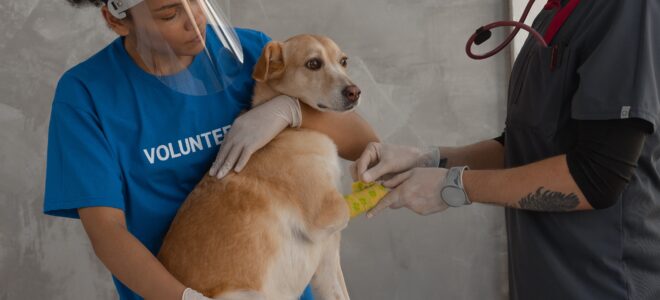Providing optimal healthcare for pets demands a comprehensive understanding of veterinary internal medicine. Empowered by expert knowledge and advanced diagnostic technology, veterinarians offer valuable solutions catering to the varying health concerns of pets. Explaining what steps an internal medicine vet takes to diagnose illnesses can guide pet owners through the process and highlight the varied facets of animal healthcare.
The Core Role of Internal Medicine Vets in Animal Healthcare
Pet Health Assessments
Pet health assessments play a key role in preventive veterinary care. A comprehensive health check-up can reveal a wealth of information about your pet’s well-being.
Here’s a breakdown:
- Preventive Care: Routine assessments help nip potential health issues in the bud, promoting longevity in pets.
- Physical Examination: This involves a close look at the pet’s overall appearance and vital signs, offering insights into their general health.
- Lab Tests: Blood, urine, and fecal tests are crucial. They detect infections, assess organ functioning, and can help reveal the presence of internal parasites.
- Final analysis: The comprehensive data collected can guide accurate diagnoses and treatment plans if a health issue is detected.
Regular health assessments are crucial for proactive pet care. They ensure your pets remain healthy, happy, and active for years.
Veterinary Diagnostic Testing
A thorough health assessment is an initial step toward keeping your pet healthy. Nonetheless, veterinary diagnostic testing sets a pivotal stage for precise disease detection.
Let’s look at its key components:
- Pet Symptom Review: The vet considers all the pet’s symptoms, which may hint at potential health issues.
- Blood Tests: Blood testing uncovers internal health problems that may not be visible through physical exams.
- Urine Tests: These tests ascertain the urinary health of pets, identifying issues that may impact kidney function.
- Fecal Tests: Fecal testing is crucial in detecting internal parasites, contributing to overall digestive health.
Through veterinary diagnostic testing, vets can accurately diagnose illnesses, enabling timely and appropriate treatment for pets.
A Peek Into Veterinary Diagnostic Procedures
Pet Illness Symptoms and Observation
Observation forms a vital part of the diagnostic process. This involves a thorough physical examination of the pet and a detailed discussion with the pet owner about changes in behavior, diet, or any other relevant symptoms. This is a crucial step in the early detection of pet diseases.
Vet Consultation for Illness Diagnosis
Post observation, expert consultation plays a crucial role in determining the necessity of subsequent tests. Here, the field of internal medicine at Animal Hospital of Nashua finds application, guiding the decision-making process founded on their specialized knowledge in diagnosing diseases and treating pets.
Discussion of Pet’s Medical Background
The pet’s medical background is reviewed, assessing past ailments, medications, and any pre-existing health conditions. The analysis helps vets anticipate potential risks and decide on appropriate diagnostic tests to confirm any suspicion of illness.
Physical Examination of the Pet
Next, a comprehensive physical examination of the pet is performed, beginning by assessing its general appearance and organ functionality. This detailed analysis covers the skin, fur condition, eyes, ears, and mouth, along with checking the pet’s vital statistics like heart rate and body temperature.
Blood Testing: The Window Into a Pet’s Health
Need for Veterinary Blood Tests
Blood tests form the backbone of the diagnostic process as they provide a broad perspective on the pet’s internal health. Blood testing in pets aids in accurate diagnosis, giving insights into the pet’s anemia status, infection, and whether the pet’s blood will clot properly.
Urinalysis: An Indicator of Animal Urinary Health
Role in Promoting Kidney and Bladder Health in Pets
Urinalysis plays a pivotal role in promoting kidney and bladder health. It provides valuable data about the functionality and condition of the pet’s kidneys and bladder, supplementing the information derived from blood tests.
Fecal Testing for Detecting Internal Parasites
Managing Pet Worm Infestation
Worm infestations are common in pets, causing significant complications if left unchecked. Regular fecal testing in pets helps detect these parasites and the extent of the infestation, informing the timely intervention of necessary treatment.
Heartworm Testing: Saving Pets from Deadly Parasites
Guarding Against Heart and Lung Parasites
Heartworm testing is vital in safeguarding pets from deadly lung and heart parasites. These tests are necessary, even if the pet is on preventative medication, as early detection often paves the road for more successful treatment.
Veterinary Surgery Services
At times, veterinary surgery services might be necessary for the diagnostic process, especially if the pet exhibits signs of internal blockages, tumors, or other abnormalities that need extensive investigation. Surgical interventions are scheduled based on the severity of the symptoms and the pet’s overall health condition.
Laboratory Services
Lab services are the backbone of any diagnostic process. Facilities offering comprehensive lab services like veterinary diagnostic imaging accelerates the diagnostic process by providing accurate and rapid results, which form the basis of the vet’s treatment plan.
Conclusion
Diagnosing illnesses in pets is a systematic process that combines expert observational skills, detailed tests, careful consultation, specialized internal medicine, and sometimes surgical intervention. These measures, together with regular health assessments and pet owners’ alertness, add layers of preventive care to protect the pets’ well-being, ensuring their health and happiness.


